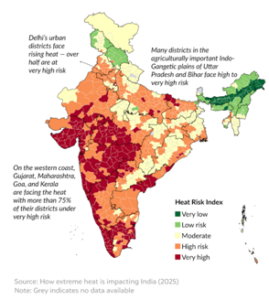Ethics Theory, TLP-UPSC Mains Answer Writing
Q. 7. How does the risk of heat vary across different states in India, and what geographical and anthropogenic factors make some areas more vulnerable than others? (150 words, 10 marks)
Introduction
India witnessed a record 554 heatwave days in 2024, more than double the previous year. With heatwaves lasting up to 20 days in April alone, states like Rajasthan, Gujarat, and Odisha face mounting climate vulnerability.
Body
Geographic Variation in Heat Risk Across India
- Northwest India (Rajasthan, Haryana): Faces extreme dry heat due to arid desert climate, low moisture, and prolonged pre-monsoon conditions.
- Central India (MP, Chhattisgarh): Records high land surface temperatures due to deforestation and dry deciduous terrain.
- Eastern Coast (Odisha, Andhra Pradesh): Experiences humid heat and high Wet Bulb Temperatures, stressing human tolerance.
- Urban Centres (Delhi, Ahmedabad): Urban Heat Island (UHI) effect elevates temperatures, especially during nights.
- Northeast and Western Ghats: Least exposed due to forest cover, rainfall, and hilly terrain which dissipates heat faster.

Geographical Factors Making Areas More Vulnerable
- Topography: Low-lying plains like the Indo-Gangetic region trap more heat compared to elevated or hilly areas, leading to prolonged high temperatures.
- Vegetation Loss: Arid zones such as Rajasthan and deforested belts in central India lack natural cooling, intensifying surface heat.
- Water Availability: Inland regions without lakes or coastal influence, like Chhattisgarh and Telangana, experience limited temperature moderation.
- Soil Moisture Deficit: Dry regions like Vidarbha heat up quickly due to poor moisture retention, raising land surface temperatures.
- Wind Patterns: Areas lacking sea breeze or monsoon winds, such as northwest India, face delayed cooling and longer heatwaves.
Anthropogenic Factors Contributing to Heat Risk
- Urbanisation: Dense built-up areas with concrete surfaces trap heat—e.g., Delhi’s UHI effect increases night temperature by 3–5°C.
- Land Use Change: Conversion of agricultural or forest lands into industrial zones intensifies local warming.
- Socio-Economic Exposure: Vulnerable populations (slum dwellers, outdoor workers) lack cooling access and heat awareness.
- Climate Change: Rising global temperatures have increased frequency of heatwaves—India saw 280 heatwave days (2010–2019), IMD.
- Planning Deficit: Limited Heat Action Plans (HAPs) outside metro cities leaves millions unprotected in Tier-2 and rural areas.
Conclusion
India needs region-wise heat plans that include more trees, better warnings, climate-safe buildings, and health support to protect people living in areas most affected by rising heat.













